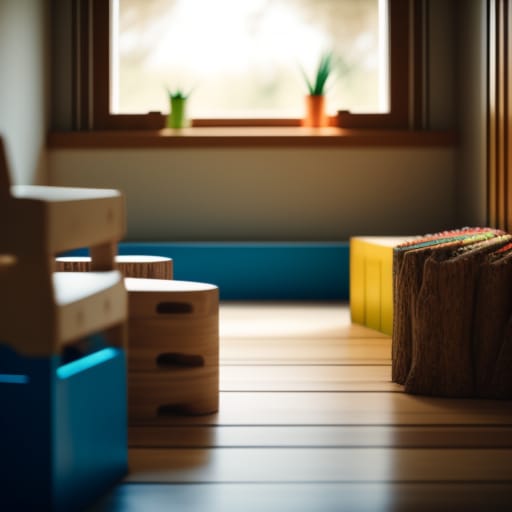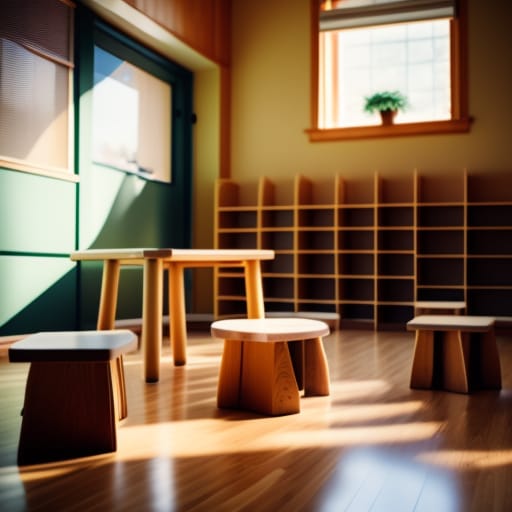Wooden blocks are timeless educational toys that have enriched childhoods for generations. This comprehensive guide explores the many benefits of natural wooden blocks and how they promote learning and development in children of all ages.

An Introduction to Natural Wooden Blocks
Wooden blocks offer a simple, open-ended play experience that sparks imagination and creativity. They have been used in early education since the 1800s, with pioneering educators like Friedrich Froebel recognizing their value in developing young minds.
Unlike plastic alternatives, natural wooden blocks provide an authentic, tactile experience for little hands. Their heft and texture aid sensory and motor skill growth. Wooden blocks made from natural hardwoods like maple, oak, and beech are non-toxic and safer for kids.
With endless combinations possible, wooden blocks build key skills:
- Fine motor control – Grasping, stacking, and balancing blocks develops dexterity
- Creativity – Imaginative, child-led play encourages inventiveness
- Math & Science – Foundations of STEM learning – shape recognition, counting, measuring, classifying, and basic engineering
- Language – Encourages vocabulary building as kids describe and name their creations
Whether used at home, preschool, or kindergarten, wooden blocks offer an open-ended, versatile learning tool. This guide covers the many benefits and types available.
Benefits of Playing with Wooden Blocks
Freeform block play provides a wealth of developmental benefits for children.
Enhanced Motor Skills
Handling and manipulating wooden blocks develops fine motor control. Little fingers learn to grasp, stack, balance, and arrange blocks in different ways. This boosts hand-eye coordination, dexterity and precision.
As toddlers learn to pick up and place blocks with purpose, it paves the way for other fine motor tasks like feeding themselves, holding a pencil correctly, and dressing themselves.
Spatial Reasoning Ability
Putting wooden blocks together in different patterns requires visualizing shapes in 3D and from different perspectives. Rotating, balancing, and combining blocks helps spatial awareness.
As children arrange and re-arrange wooden blocks, they sharpen their spatial reasoning skills. This supports skills like judging distances, recognizing patterns and shapes, mapping out directions, and mentally manipulating objects.
Creative and Imaginative Play
There is no right or wrong way to play with wooden blocks. Kids are free to build, stack, and arrange them based on their imagination and curiosity. This opens the door to all kinds of creative play.
Blocks can become castles, zoo enclosures, garages, trains, towers, robots – anything kids can dream up. Making up their own games with wooden blocks fosters creativity and inventiveness.
Early Math Concepts
Simple counting, sorting, matching, and arranging wooden blocks introduces foundational math concepts like:
- Number recognition
- Counting quantities
- Size grading (big vs small)
- Basic addition & subtraction
- Shape recognition
- Positioning & Orientation
- Grouping & classifying
Having to balance uneven stacks promotes an intuitive grasp of equilibrium and gravity. Budding engineers also get to build up and knock down creations repeatedly.
Language Development
As children describe what they are building and make up imaginative stories around wooden block creations, it expands their vocabulary and language abilities.
Coming up with names for unique block structures, recalling construction details, and explaining techniques to others involves using descriptive words and practicing speech.
Develops Focus & Problem-Solving Skills
Working through how to build sturdy structures with wooden blocks involves concentration, planning, precision, and perseverance. Completing ambitious block constructions promotes cognitive skills like:
- Focus
- Logical thinking
- Trial & error
- Spatial mapping
- Structural engineering basics
This engages kids in constructive struggle and grows their confidence in solving problems independently.
In summary, few toys match the open-ended versatility of wooden blocks. Their benefits span motor, cognitive, creative, and social-emotional development.

Types of Natural Wooden Blocks for Kids
Wooden blocks come in a variety of shapes, sizes, and materials to suit different ages and stages of learning.
Core Shape Block Sets
These starter sets contain simple squares and rectangles that can be stacked and arranged in countless ways. Available in a range of natural wood types and color tones.
Benefits
- Encourages creative, unstructured play
- Versatile – combines with any other block sets
- Helps develop control, concentration & coordination
- Promotes spatial skills, engineering concepts
Best Ages
- Toddlers & preschoolers
- Also suitable for older kids when combined with other set
Alphabet & Number Blocks
Solid wood blocks engraved with letters and numbers aid early literacy and math skills. Some feature-raised characters for tactile learning.
Benefits
- Learn letter recognition and phonics
- Spell out names and simple words
- Counting and number order reinforcement
- Can double as basic building blocks
Best Ages
- Toddlers & preschoolers learning ABCs and 123s
- Young elementary school kids practicing spelling and sums
Pattern Blocks
Precision-cut shapes like triangles, circles, cubes, arches make up these sets. Great for exploring geometry, symmetry, and fractions.
Benefits
- Learn geometry – points, faces, edges, curves
- Inspires grouping, symmetry & pattern making
- Discover fractions – halves, fourths, etc.
- Promotes logical thinking and spatial reasoning
Best Ages
- Pre-K kids and older
- Younger kids may enjoy them, but can’t fully utilize the math concepts
Gripper Blocks
Rounded wooden blocks with tapered ends fit little hands perfectly. Easy for small children to pick up and encourage pincer grip development.
Benefits
- Ideal size & shape for tiny hands to grasp
- Helps develop the pincer grip needed for writing etc.
- Stacking grippers promotes fine motor skills
- Textured wood aids sensory development
Best Ages
- Babies around 10 months old
- Toddlers improving pincer grip and coordination
Osmo Blocks
Combining digital play with physical blocks, Osmo blocks allow kids to arrange pieces to interact with educational games on an iPad or tablet.
Benefits
- Learn coding, spelling, math, music, and more
- Problem-solving and thinking skills with the tactile appeal of blocks
- Digital interactions bring traditional blocks into the virtual world
Best Ages
- Ages 4 to 10 years – kids able to use a tablet confidently
Jumbo & Giant Building Blocks
Extra large-sized wooden blocks for ambitious building projects – great for group and outdoor play. Build giant castles, mazes, and structures.
Benefits
- Ideal for collaborative building projects
- Lets kids build BIG – makes structures visible from far
- Promotes teamwork, sharing, and social skills
- Can enhance gross motor skills
Best Ages
- Pre-schoolers and older
- Supervision needed for stability and safety
This covers some of the main types – from basic starters to advanced building sets. Look for quality hardwood blocks sized suitably for a child’s age and abilities.
Getting the Most Out of Wooden Block Play
While wooden blocks are fun and educational on their own, some guidance helps kids get the most from block play:
- Start with simple rounds of stacking and knocking down blocks to build confidence.
- Add challenges e.g. make the tallest tower, use only blue blocks.
- Ask them to describe their wooden block creations.
- Suggest building something familiar first e.g. a house.
- Introduce more advanced block shapes and patterns over time.
- Display block creations proudly before dismantling and restarting.
- Occasionally join in the building yourself- comment on their techniques.
- For younger kids, demonstrate stacking techniques step-by-step.
- Collaborative projects encourage teamwork, communication, and negotiation skills.
- Ask thought-provoking questions as they play e.g. Why do you think that block fell down?
- Let creations remain up for display and imaginary play.
- Combine blocks with other materials like blocks or craft supplies for more learning opportunities.
Ensuring kids play with wooden blocks frequently in unrushed sessions lets their construction and thinking skills unfold naturally over time.
Choosing the Best Wooden Blocks By Age
With the variety of wooden blocks available, consider a child’s age, developmental stage, and interests to select suitable options:
Babies
- Textured gripper blocks support pincer grasp
- Distinct shape sorters aid identification
- Simple stacking rings reinforce coordination
1 to 2 years old Toddlers
- Large basic starter blocks of different colors
- Shape sorters combine learning and construction
- Wooden trains with stackable carriages
2 to 3 years old Preschoolers
- Alphabet blocks for letter recognition
- Themed building sets e.g. zoo animals, houses
- Interesting pattern blocks promote spatial skills
4 to 6 years Olds
- Sets to build trains, castles, cities
- Advanced builder sets with unique shapes
- Collaborative project packs like giant blocks
6 years and Up
- STEM block kits introduce physics, engineering
- Building sets that mesh with other systems like LEGO
- Programmable robotics blocks like Osmo
Consider choosing wooden blocks made from natural, non-toxic materials for safety. Select sets with storage options like cloth bags or wooden storage crates.

Fostering Development Through Wooden Block Play
Beyond the open-ended benefits of free construction play, some targeted activities with blocks can foster specific skills:
Math Skills
- Recognizing numbers, shapes, colors
- Simple counting and adding
- Sorting by size, shape, or color
- Identifying position – on, under, next to etc.
- Weighing stacks to compare heaviness
- Observing speed of falling stacks
Language Skills
- Having kids describe what they are building
- Telling stories with block scenes
- Labelling creations with written block letters
- Following verbal instructions to build something
Fine Motor Skills
- Stacking blocks vertically
- Building up flat horizontally
- Connecting blocks across gaps
- Balancing uneven stacks
- Moving blocks with precision into position
Problem Solving
- Building increasingly tall towers
- Spanning long distances between stacks
- Balancing unequal blocks in stacks
- Incorporating moving wheels/pivots
- Improvising repairs when structures collapse
Guiding play in purposeful ways stretches block abilities. But take cues from the child’s interests to keep them engaged.
Frequently Asked Questions About Wooden Blocks
Are wooden blocks better than plastic blocks?
Wooden blocks have distinct advantages over plastic blocks:
- Natural tactile texture – the smooth sanded feel of wood is more sensory and satisfying to handle.
- Non-toxic and child safe – wood like maple contains no nasty chemicals. Avoid painted/dyed blocks.
- Sustainable and eco-friendly – sourced from renewable managed forests. Biodegradable.
- Heavier and sturdier – solid wood has some heft. Very durable for long-term use.
- Classical heritage – traditional wooden blocks valued by educators for over 130 years.
What age are wooden blocks suitable from?
Wooden blocks can be enjoyed from babyhood to beyond! Large gripper blocks suit babies as young as 3 months old. Versatile starter sets work from 1 year old to adulthood!
For any wooden block, ensure sizes are suitable and present no choking hazard for the child’s age range.
How do I teach a toddler to play with blocks?
Toddlers learn by demonstration. Sit on the floor with them and start stacking blocks up and down. Encourage them to copy you. Add some gentle guidance:
- Demonstrate simple stacking.
- Use stacking toys that base pieces grip together.
- Celebrate successes – “You did it!”
- If they get frustrated, show them again.
- Introduce new ways to play once they get the hang of stacking – make trains, buildings.
- Combine blocks with stuffed toys, garages, etc.